1993 DODGE TRUCK length
[x] Cancel search: lengthPage 628 of 1502
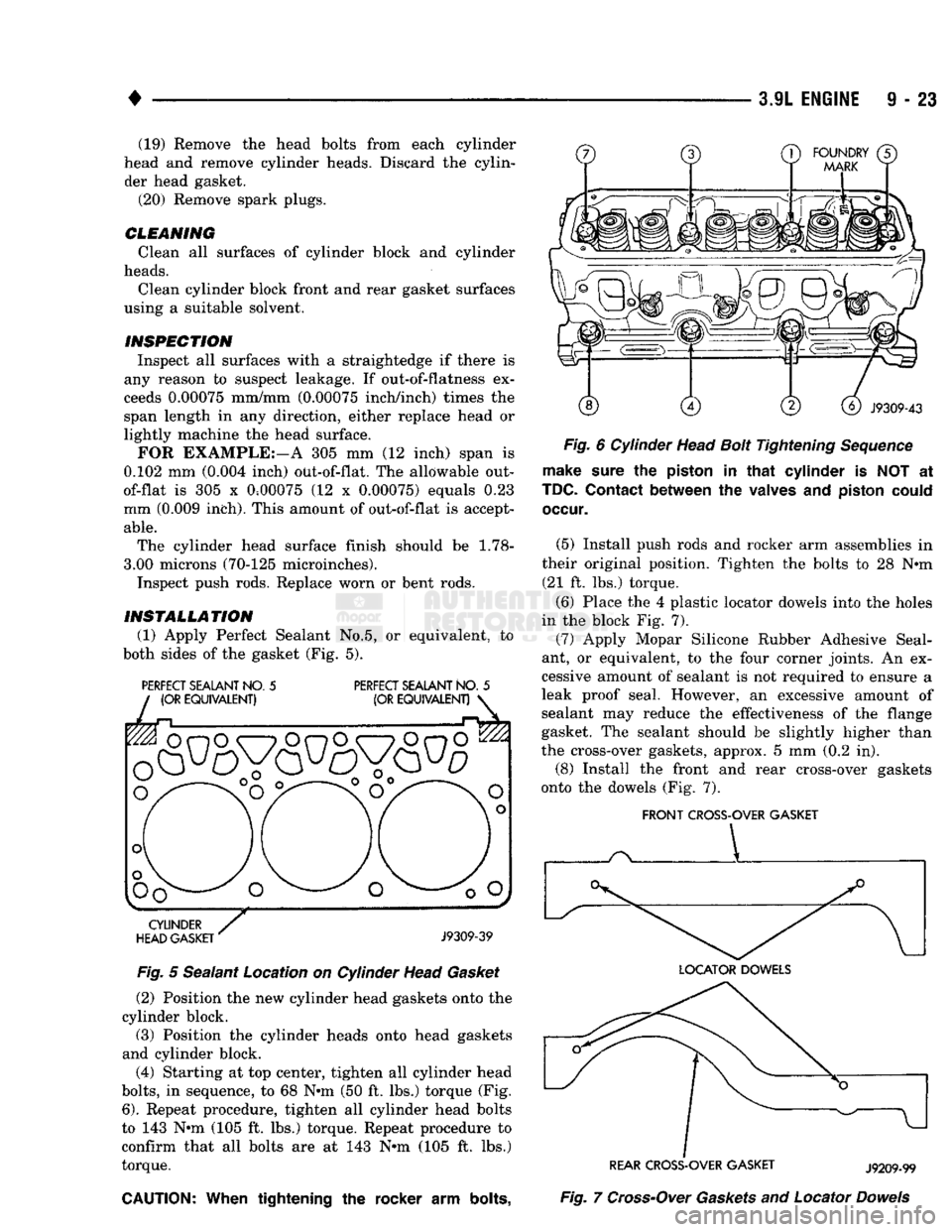
•
3.9L
ENGINE
9 - 23 (19) Remove the head bolts from each cylinder
head and remove cylinder heads. Discard the cylin der head gasket.
(20) Remove spark plugs.
CLEANING
Clean all surfaces of cylinder block and cylinder
heads.
Clean cylinder block front and rear gasket surfaces
using a suitable solvent.
INSPECTION
Inspect all surfaces with a straightedge if there is
any reason to suspect leakage. If out-of-flatness ex
ceeds 0.00075 mm/mm (0.00075 inch/inch) times the
span length in any direction, either replace head or
lightly machine the head surface.
FOR EXAMPLE:—A 305 mm (12 inch) span is
0.102 mm (0.004 inch) out-of-flat. The allowable out-
of-flat is 305 x 0,00075 (12 x 0.00075) equals 0.23
mm (0.009 inch). This amount of out-of-flat is accept
able.
The cylinder head surface finish should be 1.78-
3.00 microns (70-125 microinches). Inspect push rods. Replace worn or bent rods.
INSTALLATION
(1) Apply Perfect Sealant No.5, or equivalent, to
both sides of the gasket (Fig. 5).
PERFECT
SEALANT
NO.
5
PERFECT
SEALANT
NO.
5
Fig.
5 Sealant Location on Cylinder Head
Gasket
(2) Position the new cylinder head gaskets onto the
cylinder block.
(3) Position the cylinder heads onto head gaskets
and cylinder block.
(4) Starting at top center, tighten all cylinder head
bolts,
in sequence, to 68 N»m (50 ft. lbs.) torque (Fig.
6).
Repeat procedure, tighten all cylinder head bolts
to 143 N»m (105 ft. lbs.) torque. Repeat procedure to
confirm that all bolts are at 143 N*m (105 ft. lbs.)
torque.
CAUTION:
When
tightening the rocker arm
bolts,
Fig.
6 Cylinder Head
Bolt
Tightening
Sequence
make
sure
the
piston
in
that
cylinder is NOT at
TDC.
Contact
between the
valves
and
piston
could
occur.
(5) Install push rods and rocker arm assemblies in
their original position. Tighten the bolts to 28 Nnn (21 ft. lbs.) torque.
(6) Place the 4 plastic locator dowels into the holes
in the block Fig. 7). (7) Apply Mopar Silicone Rubber Adhesive Seal
ant, or equivalent, to the four corner joints. An ex
cessive amount of sealant is not required to ensure a
leak proof seal. However, an excessive amount of sealant may reduce the effectiveness of the flange
gasket. The sealant should be slightly higher than
the cross-over gaskets, approx. 5 mm (0.2 in).
(8) Install the front and rear cross-over gaskets
onto the dowels (Fig. 7).
FRONT
CROSS-OVER
GASKET
REAR
CROSS-OVER
GASKET
J9209-99
Fig.
7
Cross-Over
Gaskets
and Locator
Dowels
Page 631 of 1502
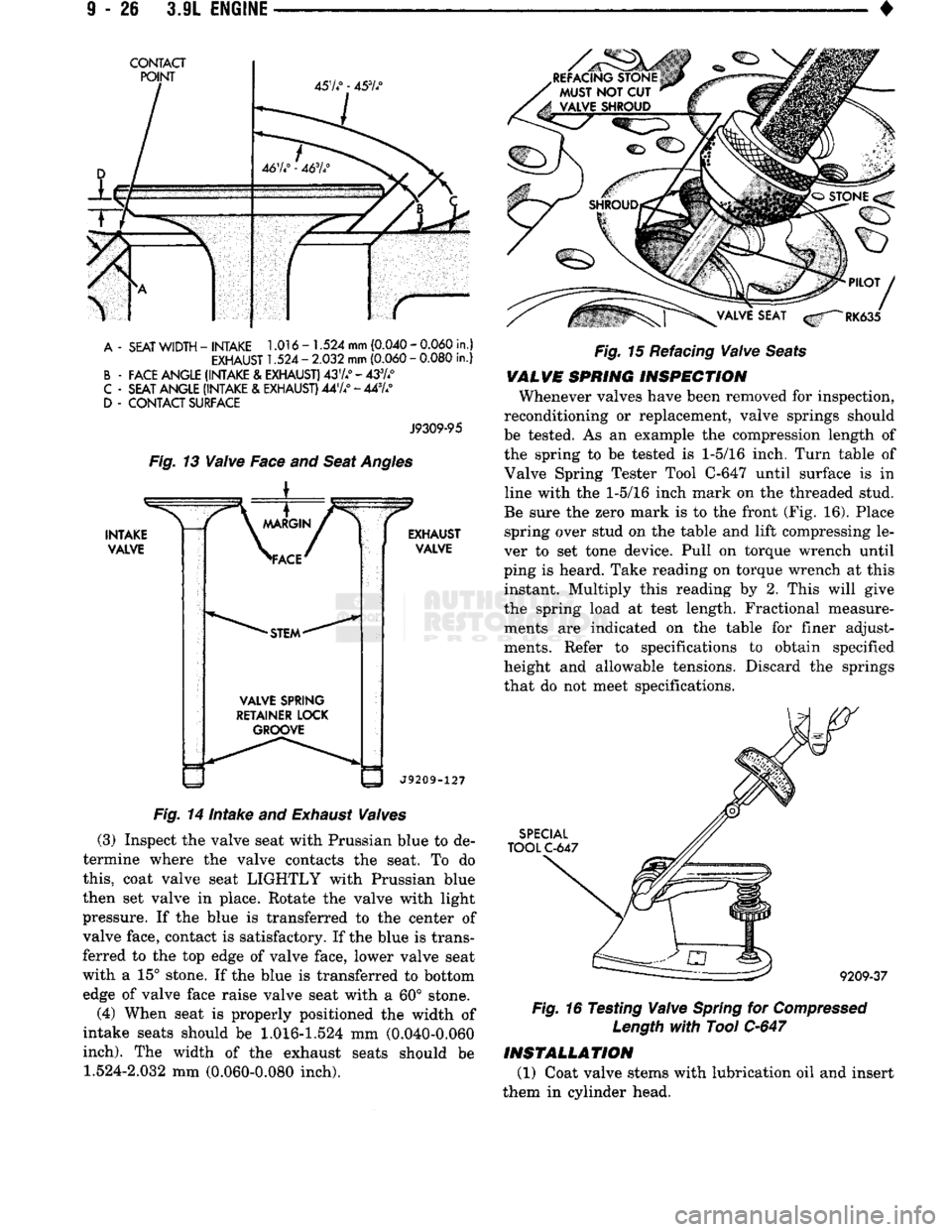
A
-
SEAT
WIDTH
-
INTAKE
1.016
-
1.524
mm
(0.040
-
0.060
in.)
EXHAUST
1.524
-
2.032
mm
(0.060
-
0.080
in.)
B
-
FACE
ANGLE
(INTAKE
& EXHAUST)
4374°
-
433A°
C
-
SEAT
ANGLE
(INTAKE
& EXHAUST)
4474°
-
44%°
D
-
CONTACT SURFACE
J9309-95
Fig.
13
Valve
Face and
Seat
Angles
i
INTAKE
VALVE
\
MARGIN
/ "
>FACE'
•STEM"
VALVE SPRING
RETAINER LOCK GROOVE EXHAUST
VALVE
J9209-127
Fig.
14 Intake and
Exhaust
Valves
(3) Inspect
the
valve seat with Prussian blue
to de
termine where
the
valve contacts
the
seat.
To do
this,
coat valve seat LIGHTLY with Prussian blue
then
set
valve
in
place. Rotate
the
valve with light
pressure.
If the
blue
is
transferred
to the
center
of
valve face, contact
is
satisfactory.
If
the blue
is
trans
ferred
to the top
edge
of
valve face, lower valve seat
with
a 15°
stone.
If
the blue
is
transferred
to
bottom edge
of
valve face raise valve seat with
a 60°
stone.
(4)
When seat
is
properly positioned
the
width
of
intake seats should
be 1.016-1.524 mm (0.040-0.060
inch).
The
width
of the
exhaust seats should
be 1.524-2.032 mm (0.060-0.080
inch).
Fig.
15 Refacing
Valve
Seats
VALVE
SPRING
INSPECTION
Whenever valves have been removed
for
inspection,
reconditioning
or
replacement, valve springs should
be tested.
As an
example
the
compression length
of
the spring
to be
tested
is 1-5/16
inch. Turn table
of
Valve Spring Tester Tool
C-647
until surface
is in
line with
the 1-5/16
inch mark
on the
threaded stud.
Be sure
the
zero mark
is to the
front (Fig.
16).
Place spring over stud
on the
table
and
lift compressing
le
ver
to set
tone device. Pull
on
torque wrench until
ping
is
heard. Take reading
on
torque wrench
at
this instant. Multiply this reading
by 2.
This will give
the spring load
at
test length. Fractional measure ments
are
indicated
on the
table
for
finer adjustments. Refer
to
specifications
to
obtain specified
height
and
allowable tensions. Discard
the
springs
that
do not
meet specifications.
SPECIAL
TOOL
C-647
9209-37
Fig.
16 Testing
Valve
Spring
for
Compressed
Length
with
Tool
C-647
INSTALLATION
(1)
Coat valve stems with lubrication
oil and
insert
them
in
cylinder head.
Page 632 of 1502
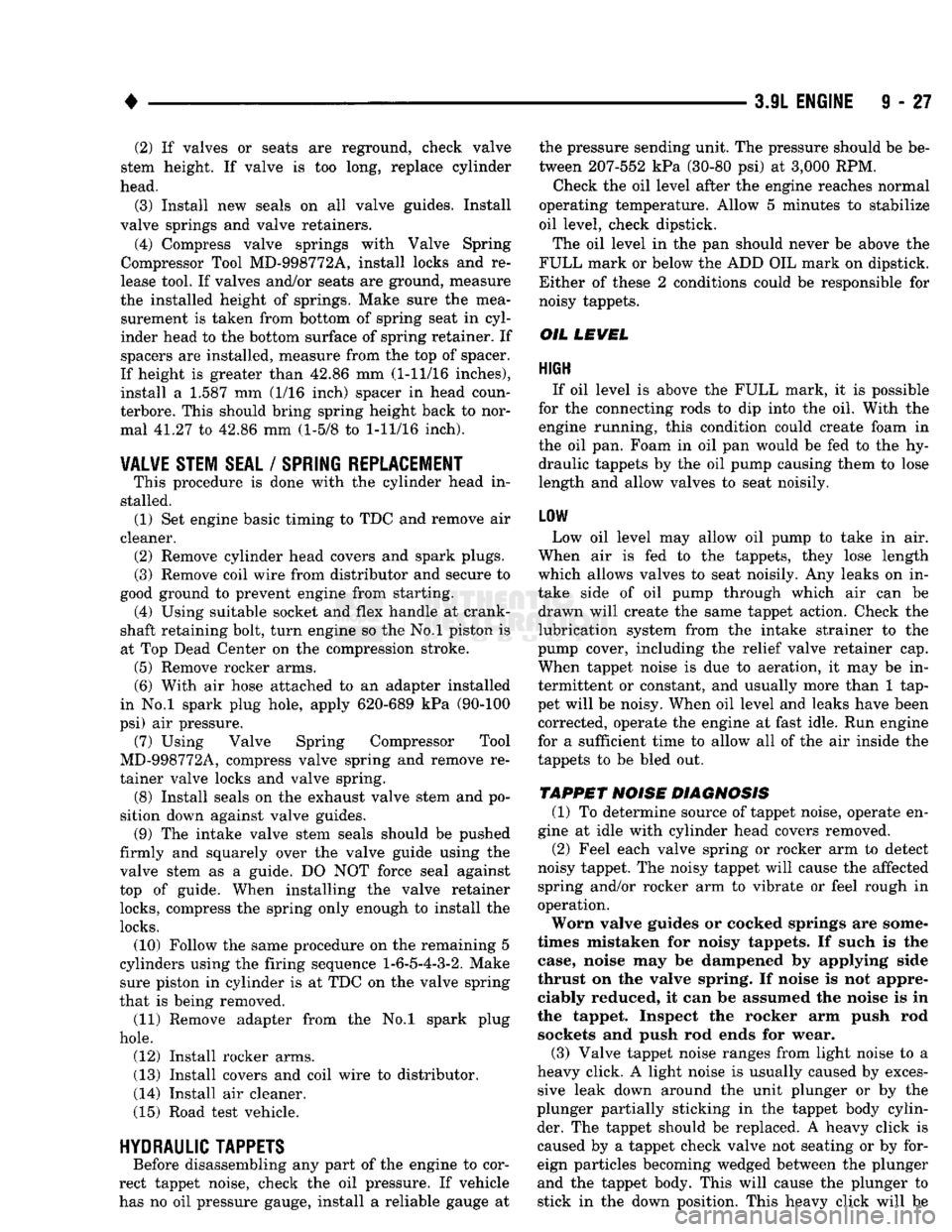
•
3.9L
ENGINE
9 - 27 (2) If valves or seats are reground, check valve
stem height. If valve is too long, replace cylinder
head.
(3) Install new seals on all valve guides. Install
valve springs and valve retainers.
(4) Compress valve springs with Valve Spring
Compressor Tool MD-998772A, install locks and re
lease tool. If valves and/or seats are ground, measure
the installed height of springs. Make sure the mea surement is taken from bottom of spring seat in cyl
inder head to the bottom surface of spring retainer. If
spacers are installed, measure from the top of spacer.
If height is greater than 42.86 mm (1-11/16 inches), install a 1.587 mm (1/16 inch) spacer in head coun-
terbore. This should bring spring height back to nor
mal 41.27 to 42.86 mm (1-5/8 to
1-11/16
inch).
VALVE STEM SEAL
/
SPRING REPLACEMENT
This procedure is done with the cylinder head in
stalled. (1) Set engine basic timing to TDC and remove air
cleaner. (2) Remove cylinder head covers and spark plugs.
(3) Remove coil wire from distributor and secure to
good ground to prevent engine from starting. (4) Using suitable socket and flex handle at crank
shaft retaining bolt, turn engine so the No.l piston is
at Top Dead Center on the compression stroke. (5) Remove rocker arms.
(6) With air hose attached to an adapter installed
in No.l spark plug hole, apply 620-689 kPa (90-100
psi) air pressure. (7) Using Valve Spring Compressor Tool
MD-998772A, compress valve spring and remove re
tainer valve locks and valve spring. (8) Install seals on the exhaust valve stem and po
sition down against valve guides. (9) The intake valve stem seals should be pushed
firmly and squarely over the valve guide using the valve stem as a guide. DO NOT force seal against
top of guide. When installing the valve retainer
locks,
compress the spring only enough to install the
locks.
(10) Follow the same procedure on the remaining 5
cylinders using the firing sequence
1-6-5-4-3-2.
Make sure piston in cylinder is at TDC on the valve spring
that is being removed. (11) Remove adapter from the No.l spark plug
hole.
(12) Install rocker arms.
(13) Install covers and coil wire to distributor.
(14) Install air cleaner.
(15) Road test vehicle.
HYDRAULIC
TAPPETS
Before disassembling any part of the engine to cor
rect tappet noise, check the oil pressure. If vehicle
has no oil pressure gauge, install a reliable gauge at the pressure sending unit. The pressure should be be
tween 207-552 kPa (30-80 psi) at 3,000 RPM.
Check the oil level after the engine reaches normal
operating temperature. Allow 5 minutes to stabilize
oil level, check dipstick.
The oil level in the pan should never be above the
FULL mark or below the ADD OIL mark on dipstick.
Either of these 2 conditions could be responsible for
noisy tappets.
OIL
LEWEL
HIGH
If oil level is above the FULL mark, it is possible
for the connecting rods to dip into the oil. With the engine running, this condition could create foam in
the oil pan. Foam in oil pan would be fed to the hy draulic tappets by the oil pump causing them to lose
length and allow valves to seat noisily.
LOW
Low oil level may allow oil pump to take in air.
When air is fed to the tappets, they lose length
which allows valves to seat noisily. Any leaks on in
take side of oil pump through which air can be drawn will create the same tappet action. Check the
lubrication system from the intake strainer to the
pump cover, including the relief valve retainer cap.
When tappet noise is due to aeration, it may be in
termittent or constant, and usually more than 1 tap
pet will be noisy. When oil level and leaks have been corrected, operate the engine at fast idle. Run engine
for a sufficient time to allow all of the air inside the
tappets to be bled out.
TAPPET
NOISE DIAGNOSIS
(1) To determine source of tappet noise, operate en
gine at idle with cylinder head covers removed. (2) Feel each valve spring or rocker arm to detect
noisy tappet. The noisy tappet will cause the affected
spring and/or rocker arm to vibrate or feel rough in
operation.
Worn valve guides or cocked springs are some
times mistaken for noisy tappets. If such is the
case, noise may be dampened by applying side
thrust on the valve spring. If noise is not appre ciably reduced, it can be assumed the noise is in
the tappet. Inspect the rocker arm push rod sockets and push rod ends for wear.
(3) Valve tappet noise ranges from light noise to a
heavy click. A light noise is usually caused by exces sive leak down around the unit plunger or by the
plunger partially sticking in the tappet body cylin der. The tappet should be replaced. A heavy click is
caused by a tappet check valve not seating or by for
eign particles becoming wedged between the plunger
and the tappet body. This will cause the plunger to
stick in the down position. This heavy click will be
Page 641 of 1502
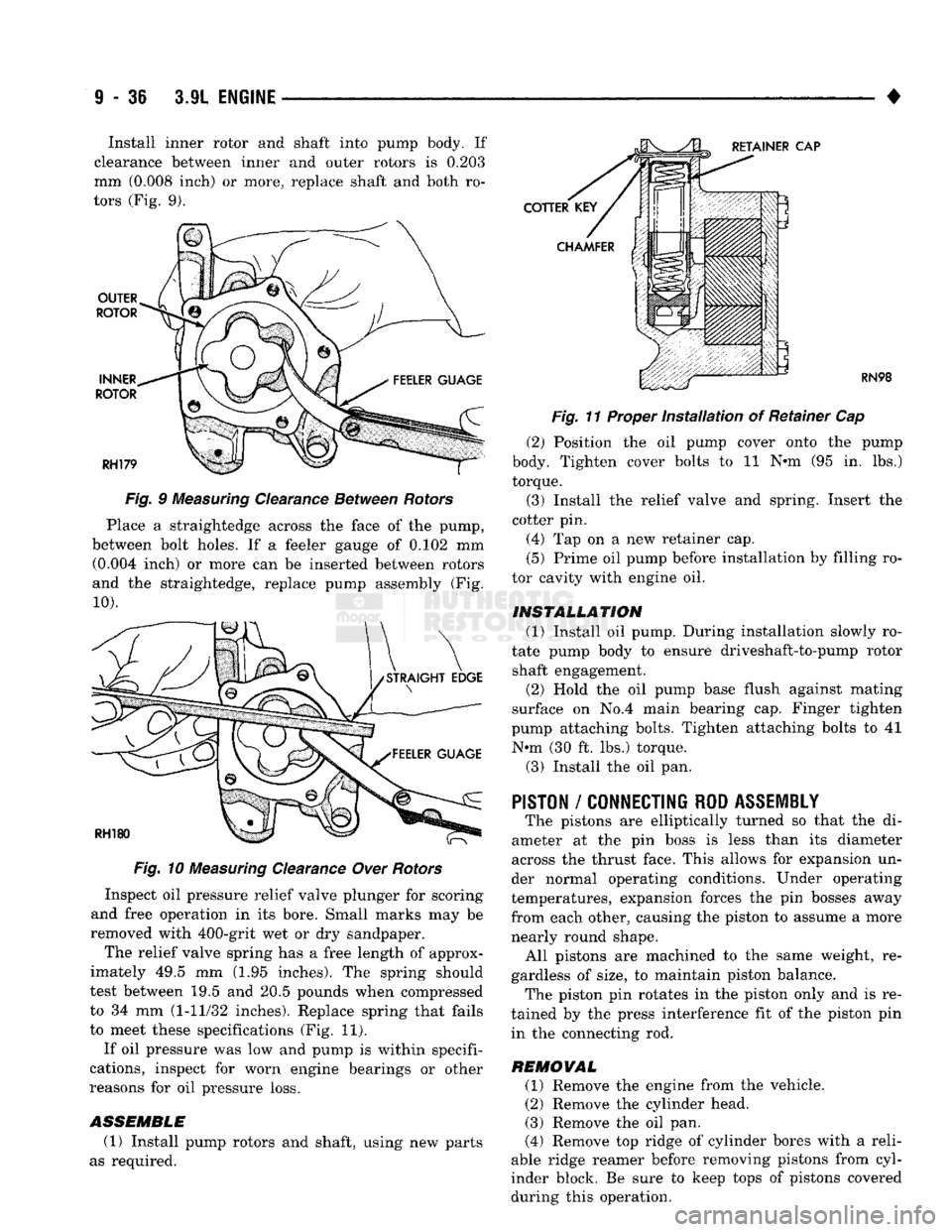
9
- 36 3.9L
ENGINE
• Install inner rotor and shaft into pump body. If
clearance between inner and outer rotors is 0.203
mm (0.008 inch) or more, replace shaft and both ro
tors (Fig. 9).
OUTER
ROTOR
INNER
ROTOR
RH179
Fig. 9 Measuring Clearance Between Rotors
Place a straightedge across the face of the pump,
between bolt holes. If a feeler gauge of 0,102 mm (0.004 inch) or more can be inserted between rotors
and the straightedge, replace pump assembly (Fig.
10).
Fig. 10 Measuring Clearance Over Rotors
Inspect oil pressure relief valve plunger for scoring
and free operation in its bore. Small marks may be
removed with 400-grit wet or dry sandpaper.
The relief valve spring has a free length of approx
imately 49.5 mm (1.95 inches). The spring should
test between 19.5 and 20.5 pounds when compressed to 34 mm (1-11/32 inches). Replace spring that fails
to meet these specifications (Fig. 11).
If oil pressure was low and pump is within specifi
cations, inspect for worn engine bearings or other
reasons for oil pressure loss.
ASSEMBLE
(1) Install pump rotors and shaft, using new parts
as required. RN98
Fig.
11 Proper
Installation
of Retainer Cap
(2) Position the oil pump cover onto the pump
body. Tighten cover bolts to 11 N-m (95 in. lbs.) torque.
(3) Install the relief valve and spring. Insert the
cotter pin.
(4) Tap on a new retainer cap.
(5) Prime oil pump before installation by filling ro
tor cavity with engine oil.
INSTALLATION (1) Install oil pump. During installation slowly ro
tate pump body to ensure driveshaft-to-pump rotor shaft engagement.
(2) Hold the oil pump base flush against mating
surface on No.4 main bearing cap. Finger tighten
pump attaching bolts. Tighten attaching bolts to 41 N-m (30 ft. lbs.) torque.
(3) Install the oil pan.
PISTON
/
CONNECTING ROD
ASSEMBLY
The pistons are elliptically turned so that the di
ameter at the pin boss is less than its diameter
across the thrust face. This allows for expansion un
der normal operating conditions. Under operating
temperatures, expansion forces the pin bosses away from each other, causing the piston to assume a more nearly round shape. All pistons are machined to the same weight, re
gardless of size, to maintain piston balance. The piston pin rotates in the piston only and is re
tained by the press interference fit of the piston pin
in the connecting rod.
REMOVAL (1) Remove the engine from the vehicle.
(2) Remove the cylinder head.
(3) Remove the oil pan.
(4) Remove top ridge of cylinder bores with a reli
able ridge reamer before removing pistons from cyl
inder block. Be sure to keep tops of pistons covered
during this operation.
Page 648 of 1502
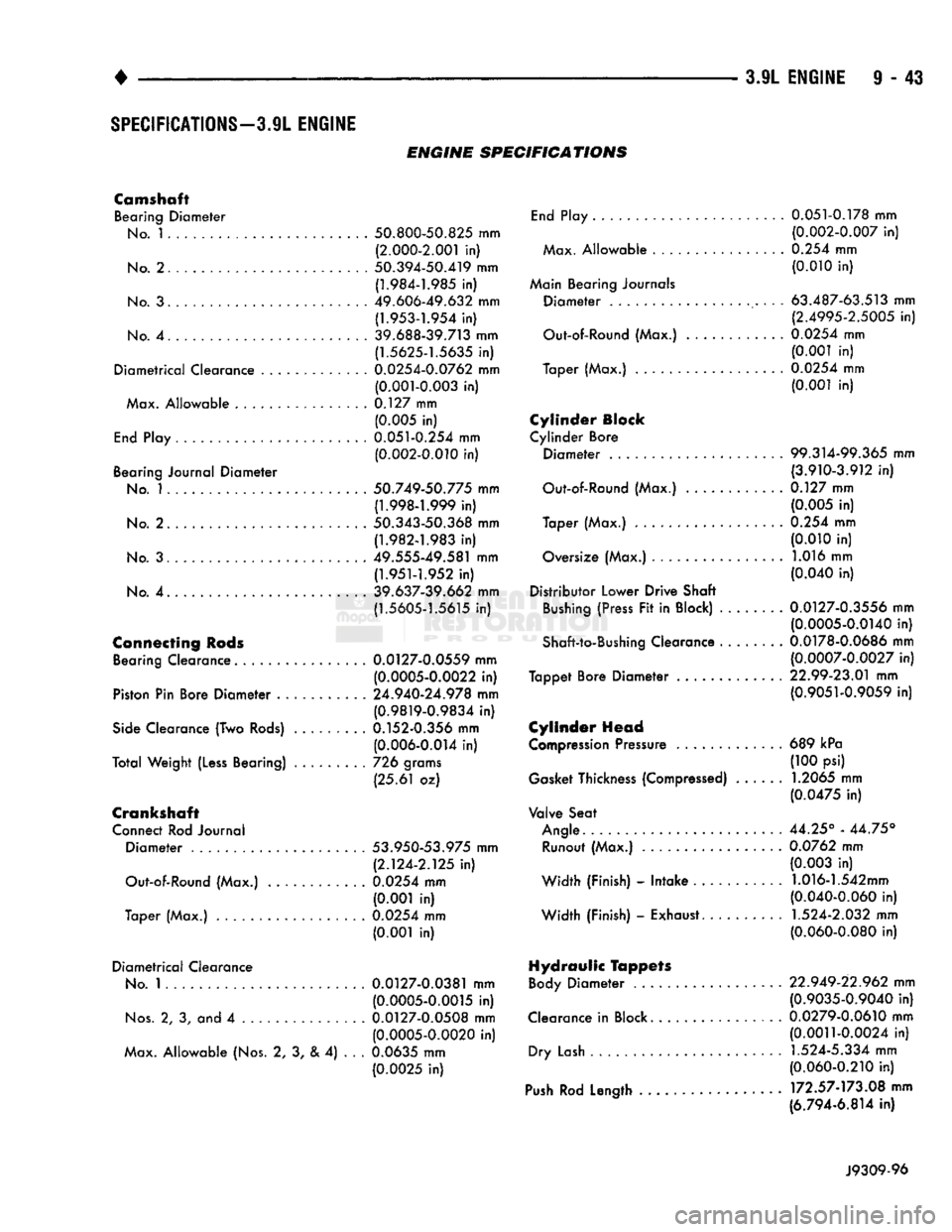
SPECIFICATIONS—3.9L
ENGINE
ENGINE
SPECIFICATIONS
Camshaft Bearing
Diameter
No.
1 50.800-50.825 mm
(2.000-2.001
in)
No.
2... 50.394-50.419 mm (1.984-1.985 in)
No.
3 49.606-49.632 mm (1.953-1.954 in)
No.
4 39.688-39.713 mm (1.5625-1.5635 in)
Diametrical
Clearance 0.0254-0.0762 mm (0.001-0.003 in)
Max. Allowable 0.127 mm (0.005 in)
End
Play 0.051-0.254 mm (0.002-0.010 in)
Bearing Journal
Diameter
No.
1.... 50.749-50.775 mm (1.998-1.999 in)
No.
2 50.343-50.368 mm
(1.982-1.983
in)
No.
3 49.555-49.581 mm
(1.951-1.952
in)
No.
4 .... 39.637-39.662 mm (1.5605-1.5615 in)
Connecting
Rods
Bearing Clearance 0.0127-0.0559 mm (0.0005-0.0022 in)
Piston Pin Bore
Diameter
24.940-24.978 mm (0.9819-0.9834 in)
Side
Clearance (Two
Rods)
0.152-0.356 mm (0.006-0.014 in)
Total
Weight
(Less
Bearing) 726 grams
(25.61 oz)
Crankshaft
Connect Rod Journal
Diameter
53.950-53.975 mm
(2.124-2.125 in)
Out-of-Round (Max.) . 0.0254 mm (0.001 in)
Taper (Max.) 0.0254 mm (0.001 in)
Diametrical
Clearance
No.
1 0.0127-0.0381 mm (0.0005-0.0015 in)
Nos.
2, 3, and 4 0.0127-0.0508 mm (0.0005-0.0020 in)
Max. Allowable (Nos. 2, 3, & 4) . . . 0.0635 mm
(0.0025 in)
End
Play 0.051-0.178 mm
(0.002-0.007 in)
Max. Allowable . 0.254 mm (0.010 in)
Main Bearing Journals
Diameter
63.487-63.513 mm (2.4995-2.5005 in)
Out-of-Round (Max.) . 0.0254 mm (0.001 in)
Taper (Max.) 0.0254 mm (0.001 in)
Cylinder Block
Cylinder Bore
Diameter
. 99.314-99.365 mm (3.910-3.912 in)
Out-of-Round (Max.) 0.127 mm (0.005 in)
Taper (Max.) . 0.254 mm (0.010 in)
Oversize (Max.) . 1.016 mm (0.040 in)
Distributor Lower Drive Shaft
Bushing
(Press Fit in Block) .... 0.0127-0.3556 mm (0.0005-0.0140 in)
Shaft-to-Bushing Clearance 0.0178-0.0686 mm (0.0007-0.0027 in)
Tappet Bore
Diameter
22.99-23.01 mm (0.9051-0.9059 in)
Cylinder Head
Compression
Pressure 689 kPa (100 psi)
Gasket Thickness (Compressed) 1.2065 mm (0.0475 in)
Valve Seat
Angle
44.25° - 44.75° Runout (Max.) 0.0762 mm (0.003 in)
Width (Finish) -
Intake
1.016-1.542mm (0.040-0.060 in)
Width (Finish) - Exhaust. 1.524-2.032 mm (0.060-0.080 in)
Hydraulic Tappets
Body
Diameter
. . 22.949-22.962 mm
(0.9035-0.9040 in)
Clearance in Block. . 0.0279-0.0610 mm (0.0011-0.0024 in)
Dry
Lash
1.524-5.334 mm (0.060-0.210 in)
Push
Rod Length 172.57-173.08 mm (6.794-6.814 in)
J9309-96
Page 649 of 1502

ENGINE SPECIFICATIONS (CONT.f
Oil
Pump
Clearance
Over
Rotors
(Max.).....
0.1016
mm (0.004 in)
Cover
Out-of-Flat
(Max.)
0.0381 mm (0.0015 in)
Inner
Rotor
Thickness
(Min.) ...... 20.955 mm (0.825 in)
Outer
Rotor
Clearance
(Max.)
0.3556 mm (0.014 in)
Diameter
(Min.) 62.7126 mm (2.469 in)
Thickness
(Min.) . . ........ 20.955 mm
(0.825 in)
Tip
Clearance
Between
Rotors
(Max).
. 0.2032 mm
(0.008 in)
Oil
Pressure
At
Curb
Idle
Speed*
41.4 kPa
(6 psi)
At
3000 rpm 207-552 kPa
(30-80 psi)
Oil
Pressure
Switch
Actuating
Pressure
(Min.) ... 34.5-48.3 kPa (5-7 psi)
*CAUTION:
If
pressure
is
ZERO
at
curb
idle,
DO
NOT run
engine
at
3,000
rpm.
Oil
Filter
Bypass
Valve
Setting
. 62-103 kPa (9-15 psi)
Pistons
Clearance
at
Top
of
Skirt
0.0127-0.0381 mm
(0.0005-0.0015 in)
Land
Clearance
(Diametrical) 0.635-1.016 mm (0.025-0.040 in)
Piston
Length
86.360 mm (3.40 in)
Piston
Ring
Groove
Depth
Nos.
1 and 2 4.572-4.826 mm (0.180-0.190 in)
No.
3 3.810-4.064 mm (0.150-0.160 in)
Weight
592.6-596.6
grams
(20.90-21.04
oz)
Piston
Pins
Clearance
In
Piston
0.00635-0.01905 mm (0.00025-0.00075 in)
In
Rod
(Interference) 0.0178-0.0356 mm (0.0007-0.0014 in)
Diameter.
24.996-25.001 mm (0.9841-0.9843 in)
End
Play..
NONE
Length
75.946-76.454 mm (2.990-3.010 in)
Piston
Rings
Ring
Gap
Compression
Rings
0.254-0.508 mm (0.010-0.020 in)
Oil
Control
(Steel
Rails)
0.254-1.270 mm (0.010-0.050 in)
Ring
Side
Clearance
Compression
Rings
0.038-0.076 mm
(0.0015-0.0030 in)
Oil
Ring
(Steel
Rails)
0.06-0.21
mm
(0.002-0.008 in)
Ring
Width
Compression
Rings
1.971-1.989 mm
(0.0776-0.0783 in)
Oil
Ring
(Steel
Rails)
3.848-3.975 mm (0.1515-0.1565 in)
Valves
Face
Angle
43.25° - 43.75°
Head
Diameter
Intake
48.666 mm (1.916 in)
Exhaust
41.250 mm (1.624 in)
Length
(Overall)
Intake
124.28-125.92 mm (4.893-4.918 in)
Exhaust
124.64-125.27 mm (4.907-4.932 in)
Lift
(Zero
Lash)
10.973 mm (0.432 in)
Stem
Diameter 7.899-7.925 mm (0.311-0.312 in)
Stem-to-Guide
Clearance
0.0254-0.0762 mm
(0.001-0.003 in)
Max.
Allowable
(Rocking
Method).
. 0.4318 mm (0.017 in)
Guide
Bore
Diameter (Std) 7.950-7.976 mm (0.313-0.314 in)
J9309-32
Page 650 of 1502
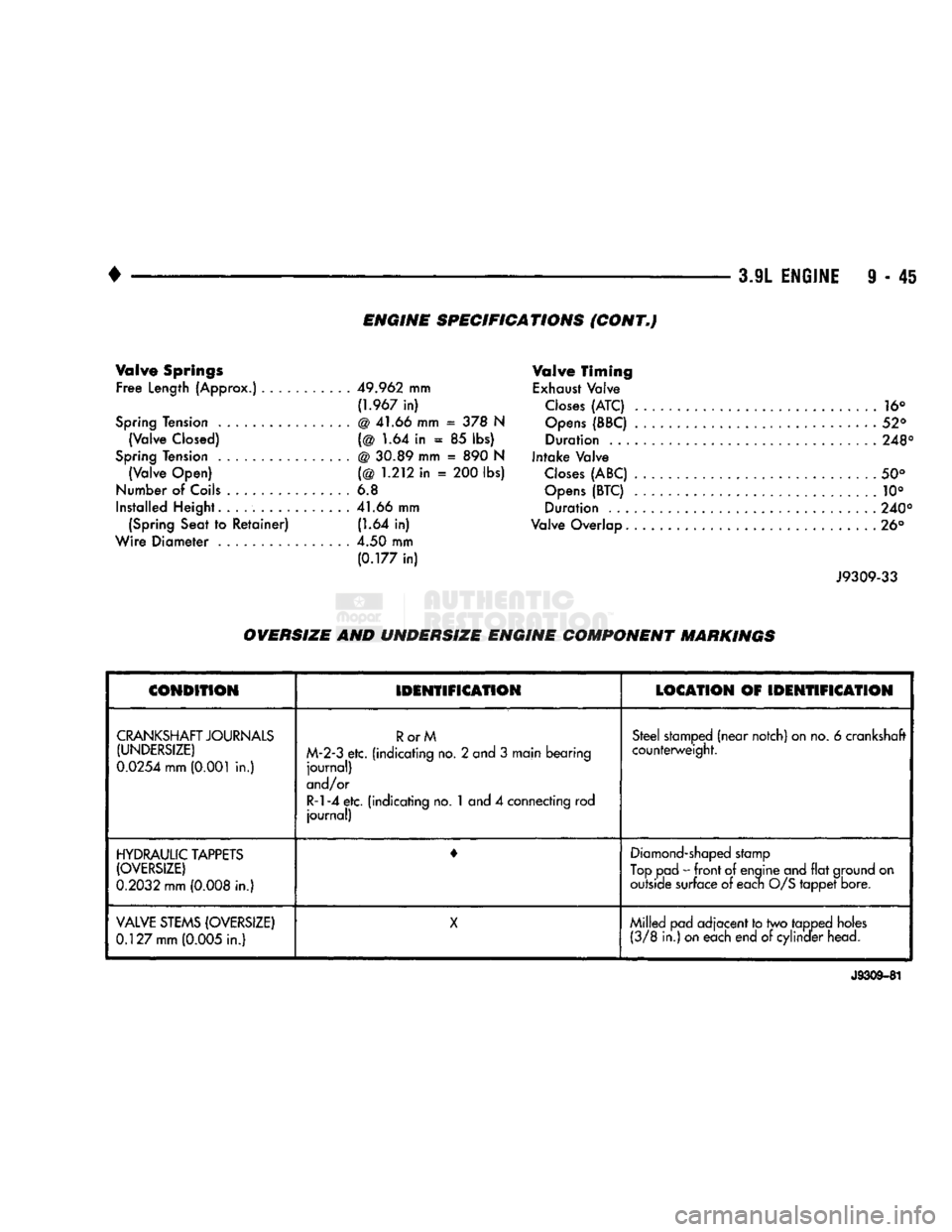
ENGINE SPECIFICATIONS
(CONT.)
Valve
Springs
Free
Length (Approx.)
49.962
mm
(1.967
in)
Spring
Tension @ 41.66 mm = 378 N (Valve Closed) (@ 1.64 in = 85 lbs)
Spring
Tension @ 30.89 mm = 890 N (Valve Open) (@ 1.212 in = 200 lbs)
Number of
Coils
6.8
Installed Height. 41.66 mm
(Spring
Seat to Retainer) (1.64 in)
Wire Diameter 4.50 mm (0.177 in) Valve Timing
Exhaust
Valve
Closes
(ATC) 16°
Opens
(BBC) 52°
Duration
248°
Intake
Valve
Closes
(ABC) 50°
Opens
(BTC) . . 10°
Duration
240°
Valve Overlap 26°
J9309-33
OVERSIZE AND UNDERSIZE ENGINE COMPONENT MARKINGS
CONDITION
IDENTIFICATION
LOCATION
OF IDENTIFICATION
CRANKSHAFT
JOURNALS
(UNDERSIZE)
0.0254
mm
(0.001
in.)
RorM
M-2-3 etc. (indicating no. 2 and 3 main bearing
journal)
and/or R-l-4 etc. (indicating no. 1 and 4 connecting rod
journal)
Steel stamped (near notch) on no. 6 crankshaft
counterweight.
HYDRAULIC
TAPPETS
(OVERSIZE)
0.2032
mm
(0.008
in.)
Diamond-shaped
stamp
Top
pad -
front
of engine and
flat
ground on outside surface of each O/S
tappet
bore.
VALVE
STEMS
(OVERSIZE)
0.127 mm
(0.005
in.)
X
Milled pad adjacent to two tapped holes
(3/8 in.) on each end of cylinder head.
J9309-81
Page 658 of 1502
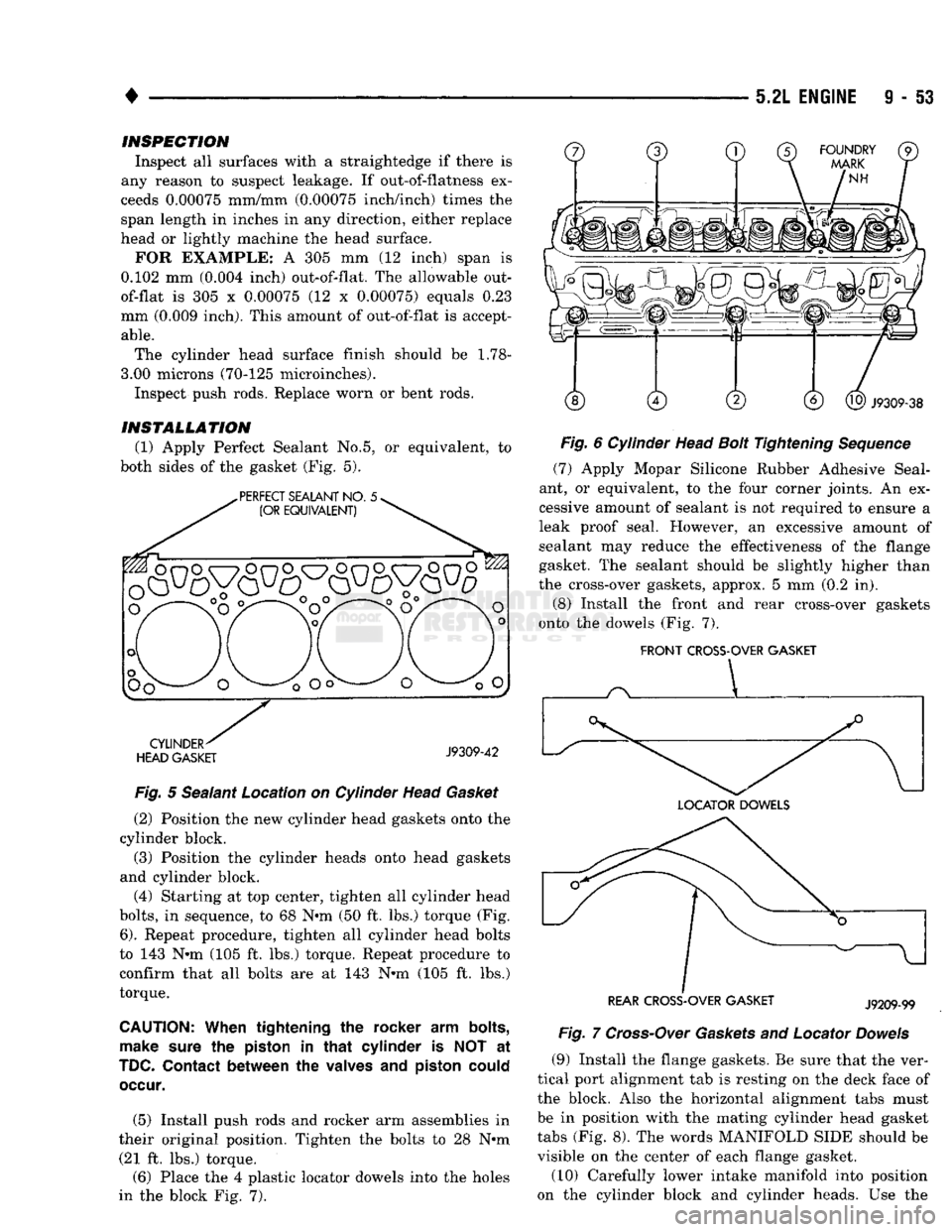
•
5.2L ENGINE
9 - 53
INSPECTION
Inspect all surfaces with a straightedge if there is
any reason to suspect leakage. If out-of-flatness ex
ceeds 0.00075 mm/mm (0.00075 inch/inch) times the span length in inches in any direction, either replace
head or lightly machine the head surface.
FOR EXAMPLE: A 305 mm (12 inch) span is
0.102 mm (0.004 inch) out-of-flat. The allowable out-
of-flat is 305 x 0.00075 (12 x 0.00075) equals 0.23
mm (0.009 inch). This amount of out-of-flat is accept
able.
The cylinder head surface finish should be 1.78-
3.00 microns (70-125 microinches). Inspect push rods. Replace worn or bent rods.
INSTALLATION
(1) Apply Perfect Sealant No.5, or equivalent, to
both sides of the gasket (Fig. 5).
Fig.
5 Sealant Location on Cylinder Head
Gasket
(2) Position the new cylinder head gaskets onto the
cylinder block. (3) Position the cylinder heads onto head gaskets
and cylinder block. (4) Starting at top center, tighten all cylinder head
bolts,
in sequence, to 68 N»m (50 ft. lbs.) torque (Fig.
6).
Repeat procedure, tighten all cylinder head bolts
to 143 N®m (105 ft. lbs.) torque. Repeat procedure to confirm that all bolts are at 143 N-m (105 ft. lbs.)
torque.
CAUTION:
When
tightening the rocker arm
bolts,
make
sure
the
piston
in
that
cylinder is NOT at
TDC.
Contact
between the
valves
and
piston
could
occur.
(5) Install push rods and rocker arm assemblies in
their original position. Tighten the bolts to 28 N»m (21 ft. lbs.) torque. (6) Place the 4 plastic locator dowels into the holes
in the block Fig. 7).
Fig.
6 Cylinder Head
Bolt
Tightening
Sequence
(7) Apply Mopar Silicone Rubber Adhesive Seal
ant, or equivalent, to the four corner joints. An ex
cessive amount of sealant is not required to ensure a
leak proof seal. However, an excessive amount of sealant may reduce the effectiveness of the flange
gasket. The sealant should be slightly higher than
the cross-over gaskets, approx. 5 mm (0.2 in).
(8) Install the front and rear cross-over gaskets
onto the dowels (Fig. 7).
FRONT
CROSS-OVER GASKET
REAR CROSS-OVER GASKET
J9209-99
Fig.
7
Cross-Over
Gaskets
and Locator
Dowels
(9) Install the flange gaskets. Be sure that the ver
tical port alignment tab is resting on the deck face of
the block. Also the horizontal alignment tabs must
be in position with the mating cylinder head gasket
tabs (Fig. 8). The words MANIFOLD SIDE should be visible on the center of each flange gasket.
(10) Carefully lower intake manifold into position
on the cylinder block and cylinder heads. Use the